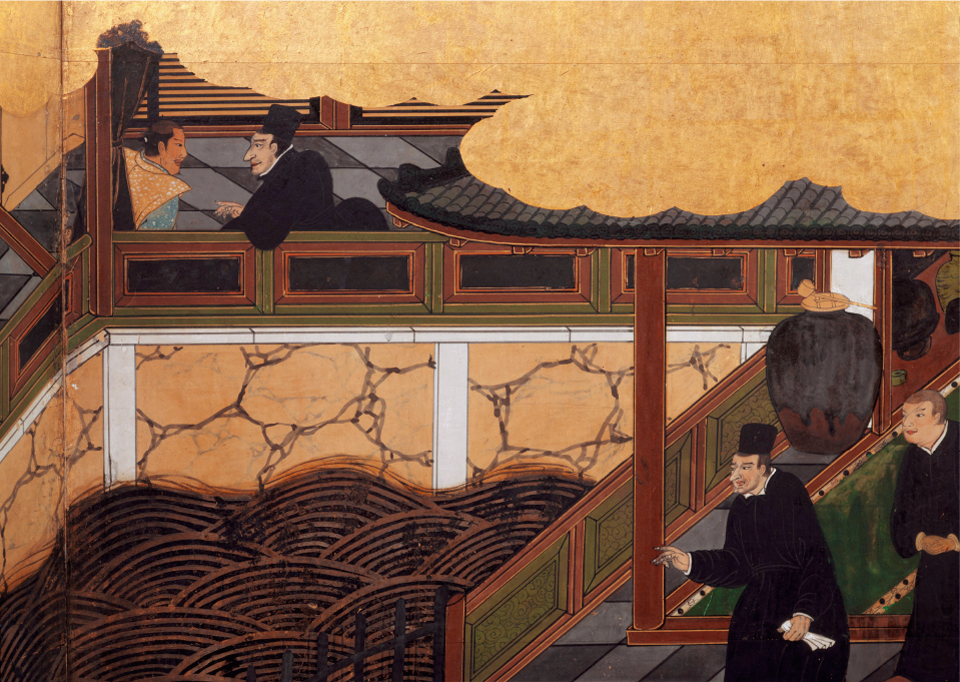This Data Collection is one of the outputs of the research project Interactions Between Rivals: The Christian Mission and Buddhist Sects in Japan (c.1549-c.1647). Hosted by CHAM - Centre for the Humanities, School of Social Sciences and Humanities, Universidade NOVA de Lisboa (NOVA FCSH), and funded by the FCT – Fundação para a Ciência e a Tecnologia, I.P. (the Portuguese National Funding Agency for Science, Research and Technology) (reference: FCT – PTDC/HIS-HIS/ 118404/2010), the Project ran from March 2012 to September 2015 with Alexandra Curvelo as PI and Angelo Cattaneo as Co-PI. The Data Collection was created and edited by Ana Fernandes Pinto and Linda Zampol D’Ortia, with the collaboration of Helena Barros Rodrigues.
The Data Collection compiles information mainly from Jesuit sources. Jesuit missionaries living in Japan, more than any other missionary presence, produced a vast corpus of written and visual sources, giving information about the political, religious, social, and cultural aspects of Japanese society; the assemblage of this information was essential for the Jesuit missionary strategy in the country in the 16th and 17th centuries. For the creation of the Data Collection, priority was given to data pertaining to the official (that is, public) discourse on Buddhism articulated by the Society, that was elaborated with the aim to inform about Japanese practices and traditions, to be later publicized in print.
The main sources of information present in the Data Collection are the history of the mission, Historia de Japam, and the collection of Jesuit letters, Cartas que os padres e irmãos da Companhia de Iesus escreuerão dos Reynos de Iapão & China… (Évora, Manuel de Lyra, 1598). The former was composed by the veteran missionary Luís Fróis from 1584 to 1594, on the orders of Jesuit General Claudio Acquaviva. The Cartas collection is composed of two volumes, printed in Évora in 1598, that collect 213 letters sent from Japan from 1549 to 1589. These two works, while differing in form and genre, give a chronological perspective of the history of the mission, providing a portrait of the main actors and their missionary work, richly contextualizing their interactions with local Buddhist authorities. The data collected from these texts were then integrated with information from Documentos de Japón, two edited volumes, which compile all the extant Jesuit manuscripts regarding Japan from 1549 to 1562. After 1589, information on the official discourse of the latter years of the mission was collected instead from the printed editions of the so-called annual letters. With the arrival of Visitor Alessandro Valignano in 1579, the missive output of the mission had begun to be regulated through the institution of a single letter for the whole enterprise, that was to be written every year and would be acceptable for printing. This decision was taken with various aims: collecting and organizing the information for the upper echelons of the Society, promoting the mission among the public and – should the occasion arise – future missionaries and edifying the readers.
The Data Collection also includes sources written by missionaries of other religious orders. A limited number of Mendicant sources are integrated to showcase the type of knowledge that these other orders had available: Marcelo de Ribadeneira’s Historia de las islas del Archipiélago Filipino y Reinos de la Gran China, Tartaria, Cochinchina, Malaca, Siam, Cambodge y Japón (Barcelona, 1601); and Jacinto Orfanell’s Historia ecclesiastica de los sucessos de la christiandad de Iapon (Madrid, 1632).
The Data Collection comprises a total of 1013 entries and approximately 230.000 transcribed words. The Collection’s organization considers the nature of the documentation and aims at supporting a research-oriented utilization, maximizing the potential of the data and thus amounting to more than a mechanical transcription of the sources.
Each textual information was identified by a number, transcribed and classified with the following fields:
i) Document’s date;
ii) Document’s place of writing;
iii) Document title;
iv) Bibliographic reference;
v) Document’s language.
Every record transcribed also accommodates five research-oriented fields:
i) Agents. Identifies both the missionaries, daimyō or Japanese monks involved in the action described and the author of the information transcribed;
ii) Subject matters. Classifies the transcription in broad themes;
iii) Content. Classifies the transcription in more detail;
iv) Location of the episode. Refers where the action took place;
v) Year of the episode. Date the time when the action took place.
The fields Place and Location of the Episode present the topographical name of the time: Miyako (instead of Kyōto), Funai (instead of Oita), Edo (instead of Tōkyō) and so on.
The keywords in the fields Subject Matter and Content were created as a tool for research. They represent a detailed, but naturally not exhaustive, level of analysis.
The information between brackets refers to an interpretation by the authors. Information followed by a question mark refers to incomplete information, either because it is not in the source, or because it is not legible.
The Data Collection offers two types of search:
- Oriented search, through a selection of keywords. Its available on the fields Date, Place, Agents, Subject Matter, Content;
- Free Search, which allows the search of words, as they appear in the sources.
Research Project Interactions Between Rivals. The Christian Mission and Buddhist Sects in Japan (c.1549-c.1647) (FCT – PTDC/HIS-HIS/118404/2010). Alexandra Curvelo (PI); Angelo Cattaneo (Co-PI). Project Data Collection Editors: Ana Fernandes Pinto and Linda Zampol D’Ortia with the collaboration of Helena Barros Rodrigues.
To cite the Data Collection
Data Collection of the Research Project Interactions Between Rivals. The Christian Mission and Buddhist Sects in Japan (c.1549-c.1647), edited by Ana Fernandes Pinto and Linda Zampol D’Ortia.
